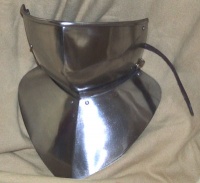Bevor: Difference between revisions
From Cunnan
Jump to navigationJump to search
(Redo) |
(categorising) |
||
| (3 intermediate revisions by the same user not shown) | |||
| Line 1: | Line 1: | ||
[[image:bevor02.jpg|right|200px|thumb| |
[[image:bevor02.jpg|right|200px|thumb|Replica 15th century bevor.]]A '''bevor''' (from French meaning ''dribble'') is a plate defence for the throat and lower face. It may or may not be articulated to increase airflow without removing the bevor. It frequently had one or more [[gorget]] plates attached to the to further protect the throat and chest immediately below this area. |
||
It was commonly worn with a [[sallet]] by [[man at arms|men at arms]] or [[noble]]s in the [[15th century]]. |
It was commonly worn with a [[sallet]] by [[man at arms|men at arms]] or [[noble]]s in the [[15th century]]. |
||
| Line 6: | Line 6: | ||
[[category:armour]][[category:full harness]][[category:15th century]][[Category:artefact (medieval)]] |
|||
[[category:armour]] |
|||
Latest revision as of 20:50, 9 June 2006
A bevor (from French meaning dribble) is a plate defence for the throat and lower face. It may or may not be articulated to increase airflow without removing the bevor. It frequently had one or more gorget plates attached to the to further protect the throat and chest immediately below this area.
It was commonly worn with a sallet by men at arms or nobles in the 15th century.
Some warriors would remove their bevor when fighting to allow them to breathe easily, but as a result became more exposed and they often paid for that exposure.
